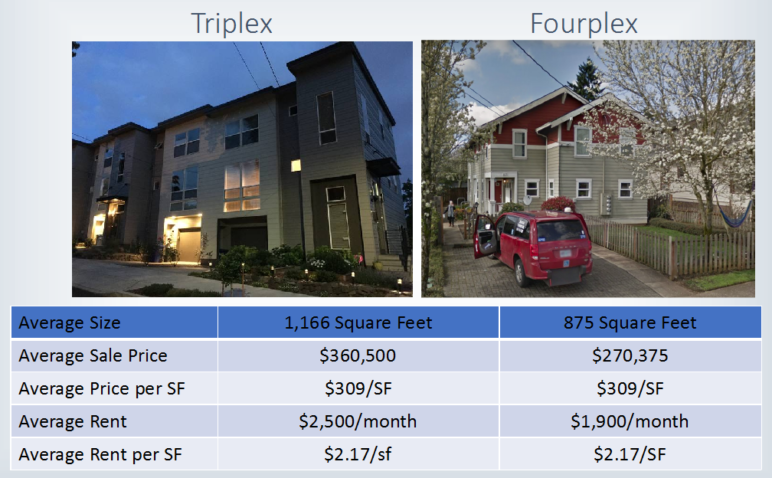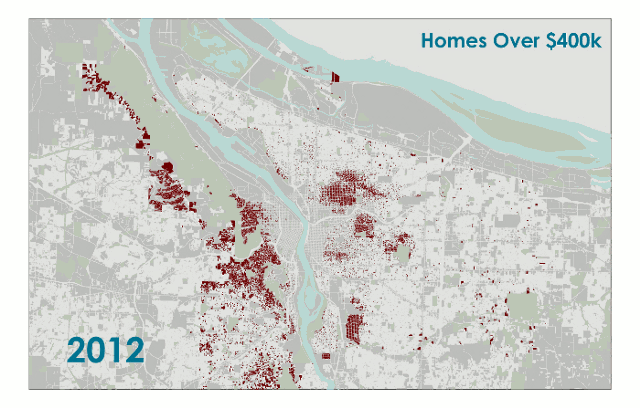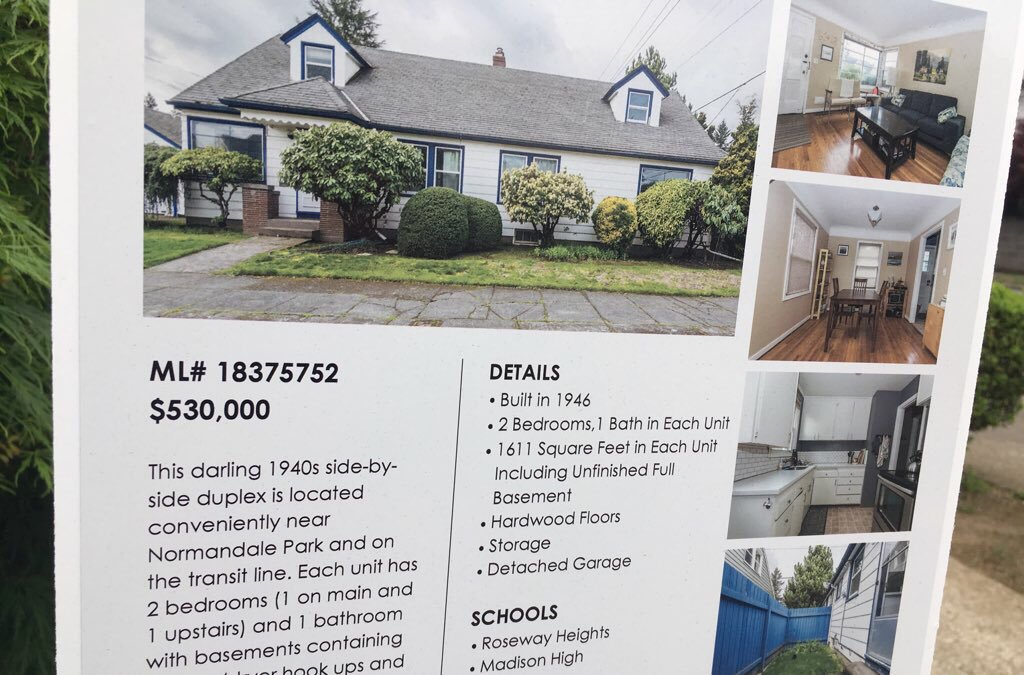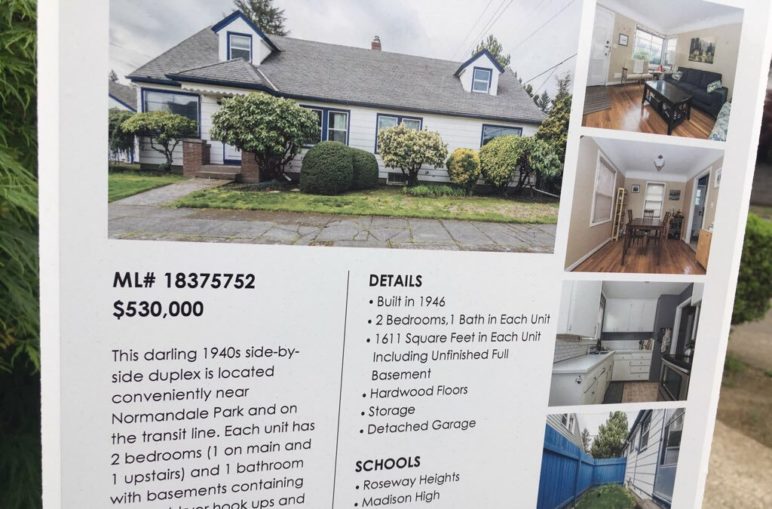Re-legalizing duplexes, triplexes and fourplexes in fancy Portland neighborhoods would create homes with “unaffordable average market-rate rents of $1,823/month,” one resident of a fancy Portland neighborhood warned the Oregon legislature this week.
The home she owns, according to the Multnomah County assessor’s office, is currently worth $529,710. (Approximately equivalent monthly rent: $3,661.)
Other residents made the exact opposite argument.
“I oppose HB2001 as it will make my neighborhood no LONGER a neighborhood but unsightly areas of quickly/cheaply built dwellings (NOT homes),” wrote one man.
As Oregonians debate a bill that would strike down local bans on “middle housing” in the state’s larger cities and other urbanized areas, it can sometimes be easy to lose perspective on one’s place in the world. For people who’ve been blessed by the housing market over the last 20 years, that probably goes double.
READ MORE: ADU Parking Quotas Are Climate Killers
So, what sort of homes is this Cascadian state arguing about legalizing?
Middle-class ones, basically.

Images courtesy of the City of Portland.
Portland’s locally initiated fourplex legalization proposal would be just one of many ways a city could meet the requirements of House Bill 2001, which would let local governments set the size and form of the newly legalized housing types.
It’s already obvious that if we don’t reform zoning one way or another, most of the new homes that get built on redevelopable low-density lots in desirable cities will be only for the rich. But if we’re in search of hard numbers to inform Oregon’s statewide bill, a Dec. 11 presentation about Portland’s proposal is a good place to start.
Under Portland’s plan, a new fourplex on a standard lot could be built to a maximum size of 3,500 square feet, total: four 875-square-foot two-bedroom homes. The city-commissioned analysis found that in a relatively close-in loop of Portland neighborhoods—Eastmoreland, North Tabor, Concordia and Arbor Lodge, as of 2017—a newly built fourplex could command rent of about $1,900 a month for each two-bedroom on the open market.
That’s just 4 percent above the federal affordability standard of $1,831 for a three-person Portland household. In other words: in Portland, legalizing fourplexes would create new homes in these fairly close-in areas that would already be affordable to middle-class Portland households on the day they’re built.
If the homes were subdivided into a little condo building and sold individually, each would go for about $270,375. With 20 percent down and a 4.75 percent mortgage, that leaves a monthly payment of about $1,467 a month for the two-bedroom.
The city-commissioned study calculated that over the next 15 years, the most profitable thing to build on a few hundred low-density lots in that ring of neighborhoods would be 1,179 such homes. (It works out to 20 new fourplexes per year.) Similarly, thousands more homes could be built elsewhere in the city, with higher prices per square foot closer to downtown and lower prices further out.
These homes would, if built and filled, prevent middle-income people from unintentionally buying their way into homes that previously belonged to poorer people. (A different city study released last week estimated that they’d reduce demolition-related displacement of low-income households in affected areas by 28 percent.) To more directly serve deeply disadvantaged households, a zoning reform like this would need to be combined with direct housing subsidies. (Portland’s plan is written to encourage that, too, and other Oregon cities should follow suit.)
But should also remember that this “middle housing” would be affordable to middle-income Portlanders—even in areas where both new and old housing prices have soared far out of reach of the middle class over the last few years—without a dime from city tax coffers.

At $400,000, 58 percent of Portlanders are essentially excluded from homeownership. Data: Metro. Images by Mike Sellinger, used with permission.
Cascadia’s cities have been growing fast, and as a result they face lots of housing problems. Middle housing is a solution for one of those problems.
It’s not the only thing we have to do. But it’s not bad, either.
Maybe that’s why, at Monday’s hearing, the supporters lined up for House Bill 2001 included the speaker of Oregon’s House, the Multnomah County chair, AARP of Oregon, Habitat for Humanity of Oregon, The Street Trust, the Mid-Columbia Housing Authority of Hood River and the Rogue Action Center of Medford, not to mention two invited technical experts: Portland State University planning professor Marisa Zapata and housing economist Mike Wilkerson.
Monday’s hearing in Salem was the first of several. You can track it and other state-level housing reform bills in the Pacific Northwest this year by subscribing to our “housing shortage solutions” newsletter here.










Paul Conte
Do you know what Kotek and others think about the following criteria:
* Minimum lot size — at what size would the minimum become too large to be “reasonable”?
* Minimum lot size — Would it be reasonable to have greater minimum lot size requirements for duplexes, triplexes and quadplexes?
* Density — Would it be reasonable to count an ADU as “one” dwelling (just) like the primary dwelling?
* Would it be reasonable to limit the number of bedrooms — per unit and/or per structure — in ADUs and plexes?
* Would it be reasonable to calculate and “effective density” (which would have a maximum) using some formulat in which number of dwellings and/or number of bedrooms were factors?
* Would it be reasonable to limit the number of unrelated occupants in a dwelling?
* Would it be reasonable to limit the maximum height of a plex to 1-1/2 or 2 stories?
* Would it be reasonable to use a “stepped” or “sloped” approach to maximum height (e.g., lower when closer to an adjacent single-family property; higher when further away)?
* Would it be reasonable to limit the maximum area that would be covered by structure and vehicle use areas (i.e., areas on which nothing can be grown)?
And, not siting or design criteria, but rather definitional criteria … an open-ended question:
* What are “reasonable”, clear and objective criteria for meeting the requirement of “used in conjunction with” and/or “as an accessory to” the (main) structure?
And finally, the “threshhold” question: What would be the defensible statutory interpretation of “reasonable.” (Hint: The term “reasonable” does appear in land use case law; however, not as “reasonable regulation.”)
Paul Conte
All I hear is “crickets” — I would have imagined that the author and other advocates of HB 2001 would have definitive answers and be happy to inform me and others who have concerns.
Rodney Rutherford
I would start by asking for each of these questions: what would be your intended effect by establishing these limits? Only then could we start to consider if the mechanisms would be reasonable methods of achieving the desired objectives…assuming that the objectives are indeed desirable.
Paul T CONTE
@Rodney Rutherford
I think you have it backwards. When a legislator proposes a bill, he or she should be able to explain it. What I think won’t effect the way that LUBA or the Court of Appeals interprets the law. If this bill were adopted as it currently stands, local jurisdictions won’t have a clue as to how to craft actual code.
I would have thought advocates wouldn’t be caught so flat-footed as to have no constructive answer.
Paul Conte
I can’t speak to Portland’s market and building costs. I’m guessing the example duplex and fourplex are in Portland. They do not represent recent prices in Eugene.
Who, of the advocates for HB 2001, can speak to the specifics of Eugene; or for that matter, specific of the hugely different neighborhood of Fairmount, Amazon, Danebo, etc.?
The article leads with an apparent attempt to marginalize the two criticisms because they seem to be inconsistent. But the reality is that HB 2001 would have different negative impacts in areas where the existing built-out environments and the markets are different. So, rather than supporting this article’s premise, these criticisms demonstrate the flaw of a “one-size fits all” dictate.
Michael Andersen
I don’t think construction prices in Eugene would be dramatically different, though they might be a bit lower. The market price of newly built housing would be quite a bit lower, as you note. One thing that I think is frequently misunderstood here is the fact that if a newly built triplex or fourplex home would need to be more expensive than other newly constructed homes nearby, then the thing that happens is not “the developer arbitrarily increases the market price in the area.” What happens is that the home *does not get built*, and indeed the price of the underlying land is unaffected because the developability of the parcel hasn’t increased. No harm, no foul.
As the slide makes clear, the price of new housing is determined mostly by the size of new housing. If the economics are different in Eugene or any affected city, then those cities can set whatever size caps they feel are appropriate to achieve their preferred rate of redevelopment.
Your criticisms of this bill have been less about “these would cost too much” and more about “allowing these options in neighborhoods like mine would constitute harm to people who currently live in such neighborhoods because they might no longer be able to park as easily on the public street.” You’ve also made the IMO totally fair point that the bill fails to account for neighborhoods (including some of the richest ones) that use private covenants to lock out development. Obviously we disagree, but I think your argument is coherent.
Paul Conte
@Michael Andersen,
If you’re going to distill my arguments, please at least do a halfway reasonable job.
You state my “criticisms of [HB 2001 are] more about ‘allowing these options in neighborhoods like mine would constitute harm to people who currently live in such neighborhoods because they might no longer be able to park as easily on the public street.’”
That’s demonstrably untrue, as anyone who has read my posts would know. FYI re parking, we’ve already done a reasonable job of solving that problem in the S-JW zone by allowing on-street parking adjacent to a residential development to be counted towards the parking requirement. In most cases within the S-JW zone, this means an ADU would not require off-street parking. But as an older neighborhood, there are some extremely narrow streets on which parking is not allowed for entire blocks.
Dismissing the need for close-by parking is just one more example of the utter disregard HB 2001 proponents have for real people’s lives. At the same time proponents pitch the “granny flat” image, they don’t want “granny” to be assured she can park close enough to manage getting to and from her car, even carrying a load of groceries or other burden. Oh, I understand … “granny” can walk five blocks to wait in the rain at a stop with no shelter in order to catch a once every half hour bus.
JB
*Where are the results of focus groups on what kind of housing people would prefer?* Do people actually want to live in habitrails or do municipal planners and developers just want to force them to?
I’m betting a vast majority of average human beings still want a stand-alone home of their own with a little private green space to relax in.
I’m also betting anyone pimping modern tenements is too afraid to ask.
Michael Andersen
64 percent of homes in Oregon are one-unit detached. We do not face a shortage of such homes, and building other homes would not be profitable (and will not be profitable) if some of us didn’t prefer to live in them.
It’s already legal to prioritize home size over location. This bill makes it legal for more people to prioritize location over home size if that’s what they prefer.
Cecile
There is plenty of data on this.
How about we let the market decide? If people need smaller homes and condos then they will be built and bought and ALL will be happy to live where they live.
If they don’t the demand wont be there and the projects/development wont happen and single family will stay as is..
A lot of people do want their own home. A lot of people also don’t want to care for a lawn, their own building and want the associated responsibilities or just cannot physically do it. Seniors are a big market share of newer condos by the way…
And as much as many want a single family home, if they cant afford it, what other solutions exist? Should they live in a van until they can? (which is an actual thing by the way.. and a growing trend at that) Condos are sometimes a choice and sometimes the new starter home of the old times. Nothing wrong with that. Housing is not always just about preference. For a lot of people it is about what budget they have, even in the higher range.
KAC
The crux issue with “infill” seems to be affordability and the secondary issue is urban sprawl. The assumption is that greater residential density will confer all sorts of benefits, chief amongst them being lower costs for purchasers and renters. The argument is that more people in less space and more building will result in lower costs and provide “missing middle” housing.
In an article from the Department of Urban Planning at MIT by Freemark (Urban Affairs Review, 1–32, 2019), the cost assumption was rigorously investigated in Chicago. Here is the article abstract, in full:
“What are the local-level impacts of zoning change? I study recent
Chicago upzonings that increased allowed densities and reduced parking
requirements in a manner exogenous of development plans and
neighborhood characteristics. To evaluate outcomes, I use differencein-
differences tests on property transaction prices and housing-unit
construction permits. I detect significant, robust increases in values for
transactions on parcels that received a boost in allowed building size. I
also identify value increases for residential condominiums, indicating that
upzoning increased prices of existing housing units. I find no impacts of
the reforms, however, on the number of newly permitted dwellings over
five years. As such, I demonstrate that the short-term, local-level impacts
of upzoning are higher property prices but no additional new housing
construction.”
Perhaps there are various unconsidered features unique to either Chicago or perhaps Portland that invalidate or weaken the author’s conclusions. Perhaps not. Much of the argument made by infill proponents in our city rests on untested assumptions. The Freemark investigation is credible: it suggests the assumptions are incorrect.
Having read HB-2001, it struck me as consistent with legislation that might have originated in the offices of former Speaker Paul Ryan. Had it been entitled, “The Housing Deregulation and Builder Support Bill”, I would not have been surprised by the contents.
In other words, both the cost assumptions (already challenged by the City commisioned Johnson report) and the Freemark study raise serious issues pertaining to affordability. The benefits to developers, REITs and various other major financial enterprises (e.g., hedge funds, commercial mortgage brokers and various elements of the building trades) are obvious. What’s currently opaque is how this will benefit the rest of us.
Paul Conte
The “Missing Middle Housing”‘ advocates all share an argument that the reason so-called “middle housing” is “missing” is because plexes and cottage clusters are prohibited by “single-family” zoning. However, very little evidence is provided to support this assumption.
Obviously (except apparently to the authors of HB 2001), CC&Rs are a huge factor, especially in newer and wealthier subdivisions. So far I’ve seen no counter-argument to the, just as obvious, motivation to include restrictive CC&Rs in all subdivisions platted after HB 2001 is adopted.
A recent thorough and credible analysis found that the main reason plexes aren’t built is that the return is too low for the risk. Read the section that discusses the “market barbell” on page 19 of The Missing Middle Study at
https://trusttheneighbors.files.wordpress.com/2019/01/missingmiddlehousingstudy.pdf
The evidence in Eugene is consistent. Eugene’s only “single-family” zone allows plexes and small lots in new subdivisions, and yet almost none of the new subdivisions included plexes or small lots. The obvious reason is that the developers do what they know how to do with low-risk and assured return, given the high demand and low supply of detached single-family homes.
A typical example of speculative argument, lacking supporting evidence, is Michael Andersen’s comment in this thread: “We do not face a shortage of such homes, and building other homes would not be profitable (and will not be profitable) if some of us didn’t prefer to live in them.”
Andersen projects his own consumer preference as evidence of the market, which actual evidence demonstrates is not correct. Whether or not one would like to see the market be different, the preference of most home-buyers, especially those with families, is a detached single-family home. This imbalance of supply-and-demand makes it a wise business decision to build SF-D homes in a “mid-to-higher” price range.
As I’ve repeatedly made clear, I helped lead a neighborhood community process that produced the Jefferson-Westside Special Area Zone, which allows ADUs (with no ownership requirement), plexes, cottage clusters and multi-family development. Of more value to “affordability” is that S-JW allows small lots and lots that are accessible only via the unimproved alleys in our neighborhood. This provides an opportunity of lower-cost home ownership. We were able to get huge buy-in from residents (and even the Home Builders of Lane County) because we crafted evidence-based lot and development standards that generally prevent significant negative impacts and encourage positive impacts.
My (and others’) problem with HB 2001 is that it violates the first and second rules of policy development:
#1 Don’t do something stupid.
#2 Make decisions based on credible evidence
HB 2001 also completely betrays Oregon’s most fundamental planning policy: Goal 1 Citizen Involvement.
Paul T CONTE
The following investigation should be a very cautionary tale for elected officials’ decision making. Our Eugene planners and “Missing Middle Housing” zealots are similarly ignoring (or hiding) facts, including the minimal benefit to housing affordability and the inevitable damage from displacement that would occur if their efforts to “stealth upzone” R-1 (the single-family zone) neighborhoods were to succeed.
Portland trumpeted rosy numbers for controversial infill plan while burying a dimmer forecast
March 12, 2019 Oregonian
“Portland planners publicly overstated by five times the number of new homes they expect a controversial infill plan could create over the next two decades.
City officials boasted that their plan projects “the addition of 24,000 units in triplexes or fourplexes” by the year 2035.
But the city’s own forecasts paint a much different picture.
Planners expect a net of fewer than 4,000 new units to be built in residential neighborhoods citywide under their infill plan, according to numbers obtained by The Oregonian/OregonLive and not previously disclosed by the city.”
https://www.oregonlive.com/portland/2019/03/portland-trumpets-rosy-numbers-for-controversial-infill-plan-buries-dimmer-forecast.html